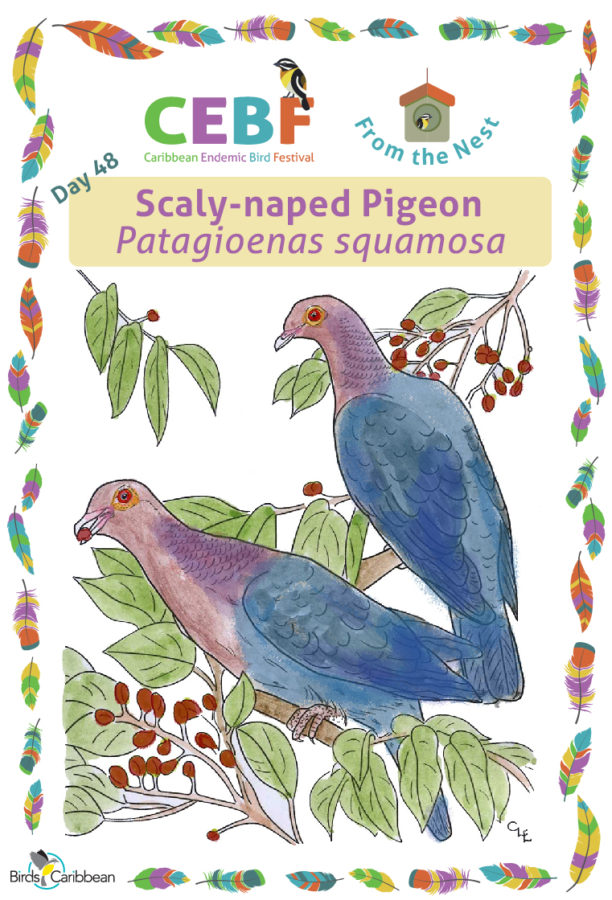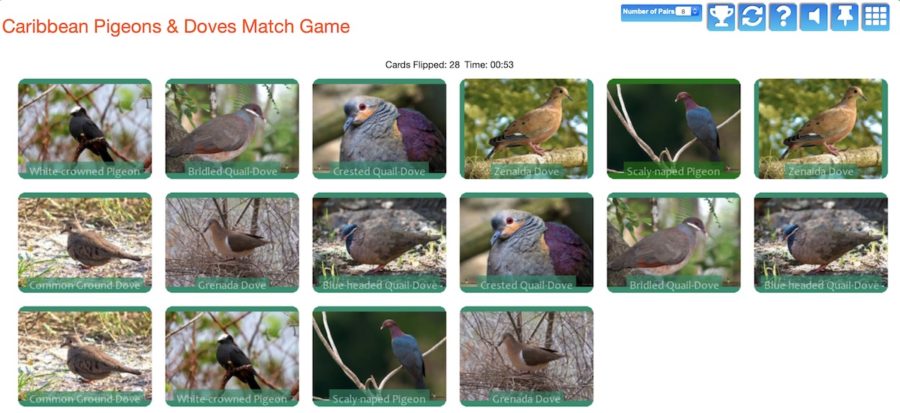Celebrate the Caribbean Endemic Bird Festival (CEBF) with us in our virtual “From the Nest” edition! Have fun learning about a new endemic bird every day. We have colouring pages, puzzles, activities, and more. Download for free and enjoy nature with your family at home.
Endemic Bird of the Day: Scaly-naped Pigeon
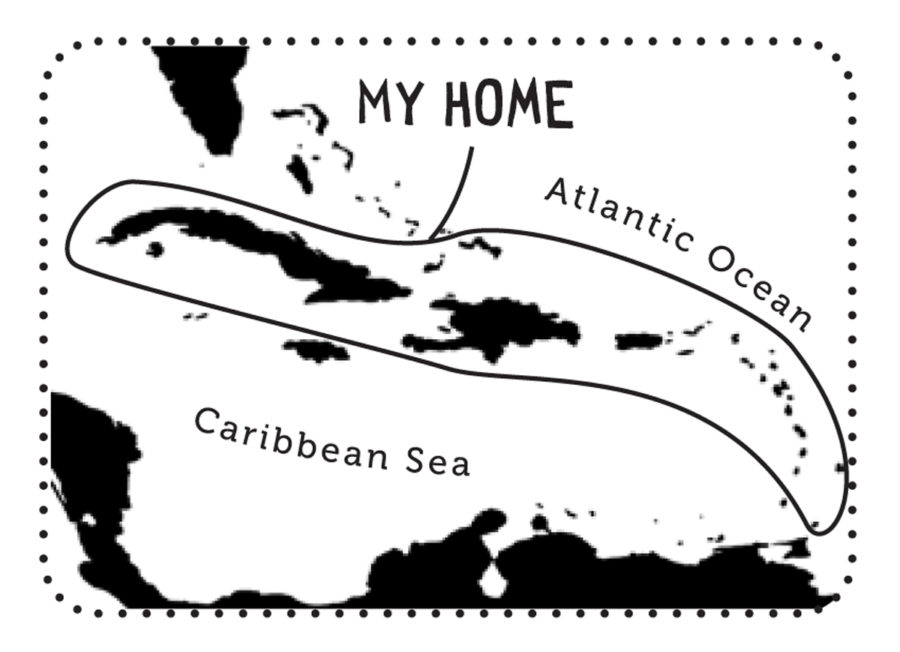 The Scaly-Naped Pigeon is a large, forest-dwelling pigeon that occurs throughout the Caribbean, except for Jamaica and the Bahamas. It feeds on seeds, fruits, leaf buds, and snails. It is arboreal, feeding in forest canopies. But it will feed opportunistically on the ground, such as on farms or following forest destruction by hurricanes. It is 14 to 16 inches in height. This pigeon, like others, are important seed dispersers, which means that they help us by spreading seeds around to plant trees.
The Scaly-Naped Pigeon is a large, forest-dwelling pigeon that occurs throughout the Caribbean, except for Jamaica and the Bahamas. It feeds on seeds, fruits, leaf buds, and snails. It is arboreal, feeding in forest canopies. But it will feed opportunistically on the ground, such as on farms or following forest destruction by hurricanes. It is 14 to 16 inches in height. This pigeon, like others, are important seed dispersers, which means that they help us by spreading seeds around to plant trees.
The Scaly-naped Pigeon is commonly found perched high in trees, that is, if you can find it! In many islands, they are skittish, probably due to hunting pressures. They can be detected by their distinctive, melodic, and maybe even wary, Who Are You? call as they peer down from the safety and cover of tall, forest trees. Sometimes, you may only hear the flapping sounds of their wings as they flee the scene to a different, undisturbed location. In other islands though, Scaly-naped Pigeons are at ease with the human population and in built-up areas. For example, they are easily seen on the Grenadine islands shared between Saint Vincent and Grenada, and are affectionately known by the locals as Ramier.
At a distance, Scaly-Naped Pigeons appear entirely slate gray in colour. At closer range you can see that the head, neck and breast are purple-red, with gorgeous iridescence on the hind neck when the sun hits just right. The neck feathers also grow in a scaly-looking pattern thus giving rise to that description in both its common and scientific name (squamosa means scaly). Scaly-Naped Pigeons can also be identified by their red legs, red eyes, and red at the base of their light-coloured beaks. Their red eyes are surrounded by a patch of bare yellow skin.
The Scaly-naped Pigeon is common on some islands, including Puerto Rico, the Virgin Islands, and some islands of the Lesser Antilles. It is less common on others due to lack of habitat or hunting pressure. It calls from January to July, with peak calls occurring with the fruiting of preferred tree species. The nest is a loose, stick platform constructed on a tree limb, epiphyte, or occasionally on the ground. The female lays 1 or 2 glossy, white eggs and incubates for about two weeks. The young fledge in 18 to 22 days. Local Names: Red-necked Pigeon, Red Head, Blue Pigeon, Mountain Pigeon, Paloma Turca, Torcaza Cuellimorada, Ramier, Ranmye Koa Wouj, Pigeon a Cou Rouge, Ramier Cou Rouge, Grote Blauwe Duif. Learn more about this species, including its range, photos, and calls here.
Colour in the Scaly-naped Pigeon!
Download the page from Endemic Birds of the West Indies Colouring Book. Use the drawing above or photo below as your guide, or you can look up pictures of the bird online or in a bird field guide if you have one. Share your coloured-in page with us by posting it online and tagging us @BirdsCaribbean #CEBFfromthenest
Listen to the song of the Scaly-naped Pigeon
The Scaly-naped Pigeon‘s song is a an emphatic cruu. . . cruu-cru-cruuuu…cruu. . . cruu-cru-cruuuu … with the heaviest accent on the fourth syllable. The first syllable is soft and separated by a pause. The last three syllables are repeated and sound like Who are you! It also gives a low-pitched rolling call rhurrrrrrrrrr.
Puzzle of the Day
Click on the image below to do the puzzle. You can make the puzzle as easy or as hard as you like – for example, 6, 8, or 12 pieces for young children, all the way up to 1,024 pieces for those that are up for a challenge!
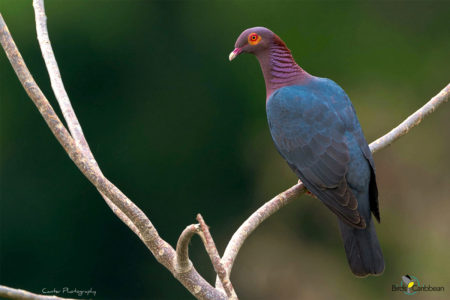
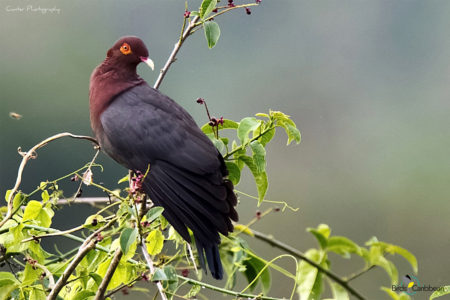
Activity of the Day
FOR KIDS & ADULTS: The Caribbean has many species of pigeons and doves – how many do you know? Become more familiar with these beautiful birds with our fun Caribbean Pigeons and Doves Memory Match Game.
Enjoy this short video of two Scaly-naped Pigeons in Christchurch, Barbados, feeding on palm fruits.

